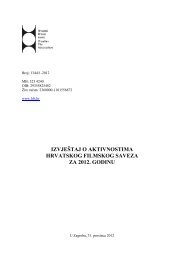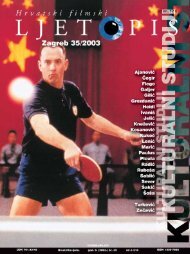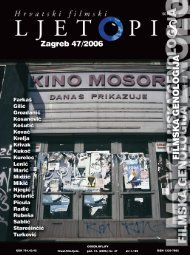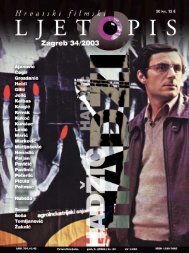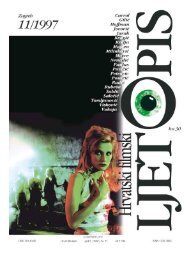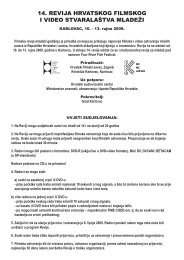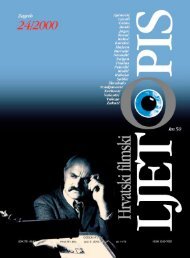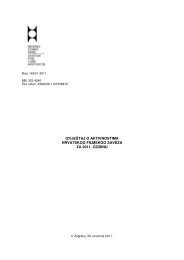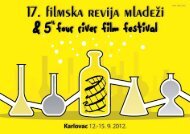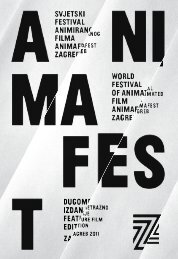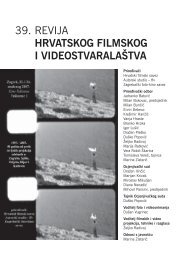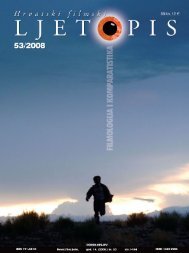Hrvatski filmski ljetopis, broj 26 (2001) - Hrvatski filmski savez
Hrvatski filmski ljetopis, broj 26 (2001) - Hrvatski filmski savez
Hrvatski filmski ljetopis, broj 26 (2001) - Hrvatski filmski savez
You also want an ePaper? Increase the reach of your titles
YUMPU automatically turns print PDFs into web optimized ePapers that Google loves.
ation of film emulsion as the two most fragile elements of<br />
film tape. These alarming figures are being partially reduced<br />
by the production of replacement film stock (new copies of<br />
film), which can be used for reproduction and storage.<br />
However, limited financial sources are the reason that some<br />
films do not have replacement copies. Moreover, in many<br />
small, poor countries even the filmmakers do not make<br />
copies, nor do the archives. The introduction of electronic<br />
recording (videotape), with all its advantages, the possibility<br />
of widespread usage, and finally digitalisation is opening<br />
new ways of dealing with the situation, but also introduces<br />
its share of problems. These particularly refer to the production,<br />
restoration and long-term storage of replacement<br />
copies. When working with an electronic medium, restoration<br />
and reconstruction happen at the micro level. In other<br />
words, digital system is used for the reconstruction of a single<br />
frame of film. Digital restoration begins with the scanning<br />
of each frame producing a digital video recording. Such<br />
video (electronic) recording is restored in a computer with<br />
the help of a specially devised software designed to make all<br />
the possible improvements (add colour, focus, eliminate<br />
vibrations, etc.), as well as eliminate all non-original parts of<br />
film footage added subsequently (mechanical faults, scratches,<br />
dirt, etc.). Eventually we obtain a new digital recording<br />
that is stored in the digital image store. Such a restored film<br />
picture is then being transferred on film tape via a film<br />
recorder. Digital recording does not only improve the technique<br />
of restoration of the original material but also enables<br />
the production of copies whose quality will not deteriorate<br />
over time. This was not possible with the classical mechanical<br />
and electronic analogue processes. Digital restoration<br />
makes it possible for a film to be well stored, while at the<br />
same time the stored material is more accessible. However,<br />
digital storage and restoration are facing serious problem.<br />
For example, it is difficult to establish the resolution of original<br />
films and to achieve the adequate resolution of the digital<br />
recording. The process of scanning presents another difficulty.<br />
There are no standardized procedures for scanning<br />
films that would satisfy the demands of archives, while the<br />
process itself is very slow and expensive. And finally, it is<br />
unavailable to most archives. The transfer of film footage to<br />
digital form and back does not yet give best results and the<br />
original picture looses some of its quality. These are the reasons<br />
why archivists display so much distrust and hesitate to<br />
accept the existing digitalizing technologies. They are particularly<br />
distrustful to the idea that digital recording should<br />
completely replace classical storing techniques, in other<br />
words, that we should allow the deterioration of the original<br />
footage on film tape. They emphasize that we should not<br />
preserve only the ’software’ picture, but also the hardware<br />
base of the original film footage and its representation —<br />
i.e. film tape and the original technology of storage and<br />
reproduction. Nevertheless, it is obvious that we must take<br />
into account the possibilities of digital technology, however,<br />
only as a parallel technology to the classical-archivist or as<br />
one of the phases in the process of restoration. Digital<br />
future demands that archivists set standards that the transmission<br />
— film — digital recording — film — has to satisfy.<br />
<strong>Hrvatski</strong> <strong>filmski</strong> <strong>ljetopis</strong> <strong>26</strong>/<strong>2001</strong>.<br />
(For example, the demand for transparency — the ability of<br />
digital technology to read all the information from various<br />
original film tapes and copies made in different phases; the<br />
demand for resolution that would correspond to the original<br />
(and reach the highest film resolution where achieved).<br />
A universal standard of transmission must be established<br />
among various digital (software) standards used in different<br />
countries and by different producers of digital technology.<br />
And finally, of course, the technology has to be economical<br />
and affordable to all). ANALITICAL CONTENT: The limitations<br />
of film medium / The progress of film technology /<br />
Video technology and various generations of electronic<br />
recordings / The restoration of film stock with the help of<br />
digital medium / The issue of resolution / Resolution in pixels<br />
/ Necessary resolutions in pixels for particular film<br />
footages / The scanning of film stock / The restoration of<br />
scanned picture / Transfer to film tape / The cost of digital<br />
restoration / Film tape used in transmission from digital<br />
recording to film tape / The restoration of faded colour<br />
films / Achievements and limitations of the photographicchemical<br />
method of restoration of film footage /<br />
Improvements of technical and technological quality of film<br />
/ Limitations and long-term passivity of the system of film<br />
archives / Photographic-chemical and digital restoration —<br />
subjective methods / Limited effectiveness of digital system /<br />
Distrust of film archivists due to unavailability, slowness and<br />
partial solutions of the digital restoration of film footage<br />
(Europe-USA) / European experiences / American experiences<br />
with the application of digital technology in the<br />
restoration of film stock / Conflicted interests of film<br />
archives and producers / Conclusions / Film archivists facing<br />
a new challenge / Disappearance of film infrastructure /<br />
Discovery of a new ideal medium for permanent storage of<br />
moving pictures / Epilogue / Notes / Bibliography.<br />
UDC: 791.44.02:004<br />
Sergej Ivasovi}<br />
Digital Editing<br />
On the operational level classical editing is a rather simple<br />
process. The editor pieces lengths of film into larger<br />
sequences, i. e. into a complete motion picture using special<br />
tools. On the creative level classical editing has one significant<br />
advantage: the editor (director, producer...) can choose<br />
which part of film he will be working on at any given<br />
moment. He has an absolute freedom of approach to all the<br />
segments of film material. This is a great incentive for the<br />
author’s creativity. However, the procedure also has many<br />
shortcomings. This mostly refers to the fact that the editor<br />
has to perform repeatedly a series of mechanical acts in a<br />
given time sequence in order to make a cut, regardless of<br />
whether the cut is good or not. The introduction of computers<br />
and digital technology in the production process<br />
solved all the above-mentioned problems, greatly changed<br />
the creative aspect of some of the key jobs in production<br />
while introducing a new time sequence of decision-making.<br />
201



